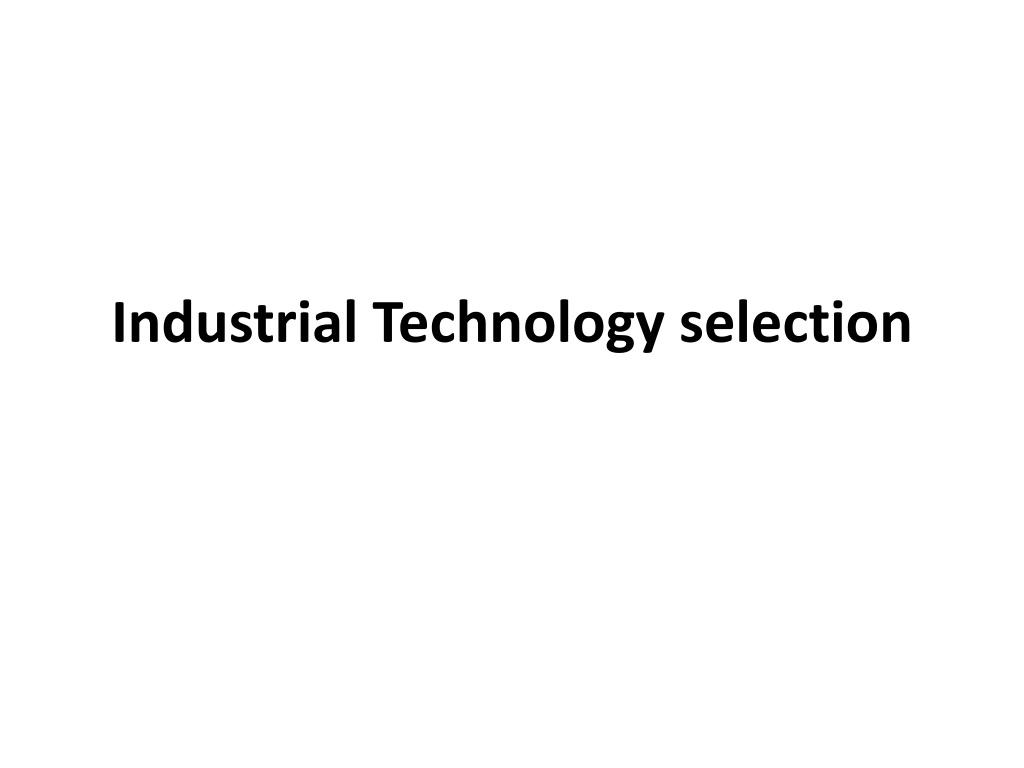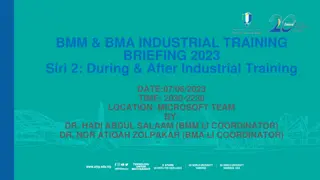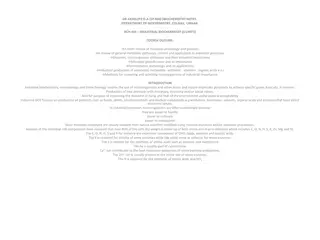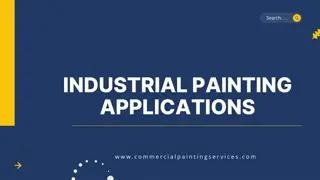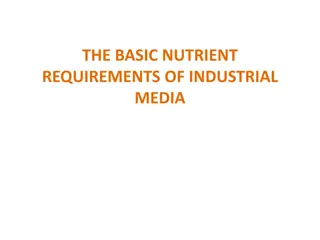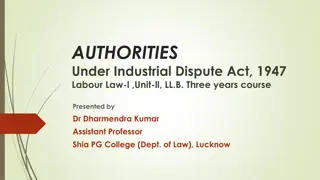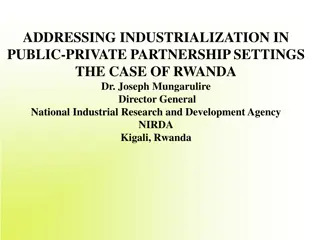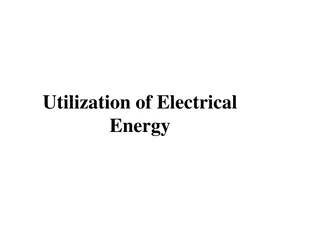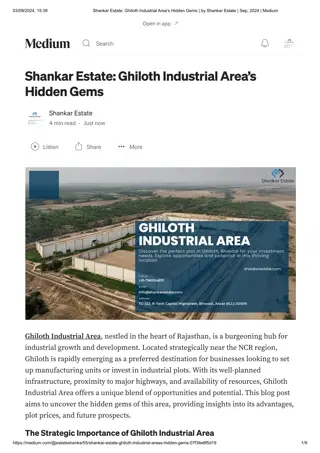Guidelines for Selecting Industrial Technology
Industrial technology involves the use of engineering knowledge to optimize production processes. The selection criteria for technology include suitability for the facility, affordability, ease of maintenance, and compliance with regulations. It is essential to choose technology that aligns with operational requirements and can be effectively maintained over its lifecycle.
Download Presentation

Please find below an Image/Link to download the presentation.
The content on the website is provided AS IS for your information and personal use only. It may not be sold, licensed, or shared on other websites without obtaining consent from the author.If you encounter any issues during the download, it is possible that the publisher has removed the file from their server.
You are allowed to download the files provided on this website for personal or commercial use, subject to the condition that they are used lawfully. All files are the property of their respective owners.
The content on the website is provided AS IS for your information and personal use only. It may not be sold, licensed, or shared on other websites without obtaining consent from the author.
E N D
Presentation Transcript
Technology is the body of scientific knowledge used in the production of goods or services. Industrial technology is the use of engineering and manufacturing technology to make production faster, simpler and more efficient. The industrial technology help a company to achieve efficiency, productivity and profitablity
Selection criteria of technology 1. Machine /Equipment should be: suitable for the level of facility and service provided acceptable to staff and patients suitable for operator skills available suitable for the local maintenance support capabilities compatible with existing equipment and consumable supplies compatible with existing utilities and energy supplies suited to the local climate, geography and conditions able to be run economically with local resources. Appropriate to setting
2. Affordable and cost-effective Machine /Equipment should be: available at a price that is cost-effective affordable in terms of costs for freight, insurance, import tax,.. affordable in terms of installation, commissioning, and training of staff to use and maintain them affordable to run (for example, cover the costs of consumables, accessories, spare parts and fuel over its life-time) affordable to maintain and service affordable in terms of the procurement process (for example the cost of a procurement agent or foreign exchange) affordable in terms of staffing costs (for example, costs of any additional staff or specialization training required).
3.Ease of use and maintenance You should choose Machine / equipment: for which you have the necessary skills in terms of operating, cleaning, and maintenance for which instructions and manuals are available to you in a suitable language for which staff training is offered by the supplier for which local after-sales support is available with real technical skills which offers the possibility of additional technical assistance through service contracts which comes with a warranty/guarantee, covering a reasonable length of time, for which you understand the terms. which offers a supply route for equipment-related supplies (for example, consumables, accessories, spare parts) which offers assured availability of these supplies for a reasonable period (up to 10 years).
4. Conforms to existing policies, plans and guidelines You should choose Machine / equipment: according to your purchasing and donations policy according to your standardization policy according to the technology level described in the Model which is deemed to be suitable, having studied available literature and compared products which is deemed to be suitable, having received feedback regarding previous purchases .
Preparing specification of equipment Equipment purchased without a detail specification relies on the vendor to supply their standard equipment or to fabricate according to their own procedures. A properly prepared equipment specification will define the performance requirements of the equipment, materials of construction, fabrication methods and procedures, test and inspection requirements, etc.
Component of specification 1. Scope 2. Standards, Codes and Specifications 3. Materials of Construction 4. Design Basis 5. Guarantees 6. Testing and Inspection 7. Documentation
1.Scope The scope defines the requirements of the specification and gives a brief description of the project. The scope may also include a general description of the application or service in which the equipment will be placed 2. Standards, Codes and Specifications This section of the specification defines the codes and standards to be used for the design, fabrication, erection, etc. of the equipment. The applicable codes and standards to be used will depend on the location of the plant which will define the laws, rules and regulations to be used.
3. Materials of Construction The materials that will be used for the fabrication of the equipment need to be specified clearly so that the equipment performs properly from a mechanical and corrosion point of view
4. Design Basis The design basis for a piece of equipment needs to be specified in detail so the vendor has sufficient information to design or size the equipment. Process conditions (i.e. flows, temperature, concentrations, pressures, etc.) Site conditions (i.e. ambient temperatures, barometric pressure, seismic zone, precipitation, etc.) Noise limitations Utilities (i.e. steam, compressed air, water, cooling water, fuel, etc.) Dimensions
5. Guarantees The specification and purchase of equipment generally includes for some form of guarantee of quality or performance. Any mechanical equipment should be guaranteed against defective design, material, workmanship, etc. for the period of time specified in the purchase order agreement.
6. Testing and Inspection Testing and inspection of the equipment is required to ensure that the equipment will meet its design intent. FAT and SAT Radiography is generally used to examine the quality of the welds used to fabricate the equipment. A hydrostatic test is required for all pressure vessels in accordance with the applicable codes (i.e. ASME). The test requirements for rotating equipment like pumps, fans and blowers will be different than fabricated equipment Mechanical running test Overspeed test Noise level test Performance test
7. Documentation Process and Instrument Drawing (P&ID) General Arrangement Drawings Electrical Drawings High-pressure pump curves Operation and maintenance manuals Equipment drawings Material certificates
Plant Erection and commissioning
Plant erection Signing the contract with potential supplier Opening of L/C Perform Factory Acceptance Testing (FAT) Perform Logistics related booking document Packing list Bill of lading Certificate of origin China Inspection Quarantine (CIQ) Commercial invoice
Supplier Name and detail Address Buyer company name and detail address Commercial Invoice Number LC number ( ZBLC02108/2012) Exchange control permit number ( ZEB/ZBH/01-03218/2012) TIN Number (0026439437)
Prepare foundation of the machinery as per the foundation drawing and specification Foundation requirement Foundation ancourage procedures Perform Site Acceptance Testing (SAT) Install the machinery Follow the installation drawing and manuals P&ID diagram
Commissioning Commissioning is a systematic process of ensuring that all the systems perform interactively according to the contract documents, the design intent and the owner s operational needs. This is achieved ideally by beginning in the pre- design phase with design intent development and documentation, and continuing through design, construction and the warranty period with actual verification through documentation of performance. review, testing and
Pre-Commissioning (or Unit test ): the checking and testing of equipment prior to their cold commissioning with power and air. Such works shall consist of testing the alignment and direction of rotating parts, the verification of the wiring and cabling, the verification of the PLC system, verification of correct mounting of piping, verification of correct mounting of valves and actuators, cold pressure testing of piping and vessels, etc. Pre-commissioning checks, when completed, will release individual items of equipment to be powered up and made available for inclusion in the cold commissioning phase.
Cold-Commissioning: the no-load, dynamic testing (including the starting-up of motors and other electrical equipment, flushing and cleaning of tanks and piping if applicable, adjustment and regulation of protective devices, functional tests, leakage and pressure tests, inspection of bearings, etc.) and operation of equipment for a period of time. This will be mainly as individual items, but may involve running some of the equipment in sequence.
Hot Commissioning: this will include the introduction of fuel (waste), process gas and reagent (including the boiling out of pressure parts, curing of the refractory, blowing of steam pipe to turbine, etc). The whole plant will be tested, operating in sequence under full load conditions.
